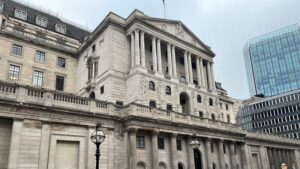While QE2, like the US’s ‘Twist’, may help keep yields down, it is no panacea: it may prove counter-productive.
First, QE failed to have the desired effect the first time round. It is true of course that QE1 (from March 2009 to January 2010) did loosen conditions further at a time when nominal policy rates were already close to zero.
BoE estimates suggest that QE1 (BoE buying of gilts and small amounts of corporate debt and commercial paper) had the equivalent effect of slicing an extra 150bps or more off Bank base rate.
On this basis then, the UK has for two years been running a true nominal policy rate of not 0.5%, but minus 1% (or minus 3% to 4% in real terms).
However, the fact that GDP and money supply growth have been visibly lacking confirms that the inflation QE1 spawned came more by the back door, by inflating oil and other asset prices, than the more direct, consumer route hoped for in 2009. By running overwhelmingly down this first channel, QE acted more like a tax.
Cash will stay cheap, but with confidence fragile and banks repairing their own balance sheets, QE2 surely again risks eroding disposable incomes.
Practical questions
There is some irony to this, in that QE2 risks undermining the BoE’s own justification for using it to assuage “the squeeze on households’ real incomes (that)…weigh on domestic spending” (as per the MPC statement, 6 October).
Added to that are practical questions about (a) the willingness of banks and other institutions to sell back their gilts while the attraction of other assets is not obvious; (b) the incentive from ongoing regulatory pressure for them to hold onto their gilts; and (c) even if they do sell, whether banks will raise lending?
Second, more than QE2 is needed to do the heavy lifting out of consumer recession. QE may keep yields down, but until confidence returns, disinflationary forces ease, consumers repair balance sheets, and the dark cloud of the eurozone dissipates, it offers only a limited leg-up, if any, to growth.
Real household expenditure not only remains about 6% off its pre-crisis level, its fall over the past year has placed consumers in a technical recession. And most of this before the second round of fiscal tightening kicked in, in April. This suggests the Office for Budgetary Responsibility’s growth assumptions will have to be revised down again – to nearer 1% year-on-year for each of 2011 and 2012 (from 1.7% and 2.5%) for the Chancellor’s autumn statement on 29 November.
Sterling pressures
Then there’s the flip side. If further rounds of QE do impact, they risk backfiring if they again erode disposable income, and/or the hit to sterling forces the MPC to raise rates prematurely. Each would quash growth. The pound may have fallen 25% since the crisis, but with little benefit to trade.
Our inflation projections accord with the Bank’s view that the CPI can head back to target at current Bank rate, but not until 2013, versus the Bank’s expectation of the end of 2012. When rates do eventually rise, our policy looseness analysis – of how far from average a country’s monetary and fiscal stance will lie – suggests that when economic growth normalises, the neutral Bank rate will probably be no higher than 1.5%. This is easily lower than the BoE’s historic average close to 5%.
So, while 2012 becomes the UK’s fifth year running of ultra loose policy, the hope is that more QE doesn’t end up unintendedly throwing out the baby (growth) with the bath water.







